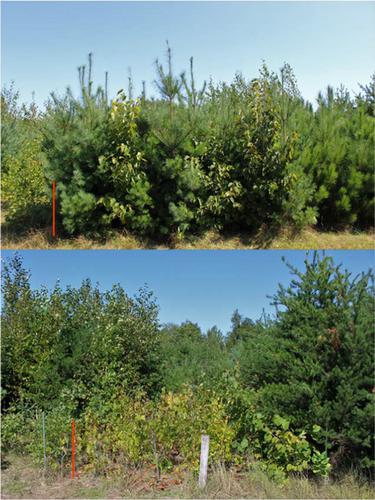Our official English website, www.x-mol.net, welcomes your
feedback! (Note: you will need to create a separate account there.)
Physiological responses to light explain competition and facilitation in a tree diversity experiment
Journal of Ecology ( IF 5.3 ) Pub Date : 2021-03-03 , DOI: 10.1111/1365-2745.13637 Shan Kothari 1, 2 , Rebecca Montgomery 3 , Jeannine Cavender‐Bares 1, 4
中文翻译:

对光的生理反应解释了树木多样性实验中的竞争和促进作用
更新日期:2021-05-12
Journal of Ecology ( IF 5.3 ) Pub Date : 2021-03-03 , DOI: 10.1111/1365-2745.13637 Shan Kothari 1, 2 , Rebecca Montgomery 3 , Jeannine Cavender‐Bares 1, 4
Affiliation

|
- Ecologists often invoke interspecific facilitation to help explain positive biodiversity–ecosystem function relationships in plant communities, but seldom test how it occurs. One mechanism through which one species may facilitate another is by ameliorating abiotic stress. Physiological experiments show that a chronic excess of light can cause stress that depresses carbon assimilation. If shading by a plant's neighbours reduces light stress enough, it may facilitate that plant's growth. If light is instead most often a limiting factor for photosynthesis, shading may have an adverse, competitive effect.
- In a temperate tree diversity experiment, we measured stem growth rates and photosynthetic physiology in broadleaf trees across a gradient of light availability imposed by their neighbours. At the extremes, trees experienced nearly full sun (monoculture), or were shaded by nearby fast‐growing conifers (shaded biculture).
- Most species had slower growth rates with larger neighbours, implying a net competitive effect. On the other hand, the two most shade‐tolerant species (Tilia americana and Acer negundo) and the most shade‐intolerant one (Betula papyrifera) had faster stem growth rates with larger neighbours. The two shade‐tolerant species had the greatest increases in photoinhibition (reduced dark‐acclimated Fv/Fm) across the gradient of increasing light availability, which suggests they are more vulnerable to chronic light stress. While most species had lower carbon assimilation rates in the shaded biculture treatment, T. americana had rates up to 25% higher. T. americana also dropped its leaves 3–4 weeks earlier in monocultures, curtailing its growing season.
- We conclude that although large neighbours can cause light limitation in shade‐intolerant species, they can also increase growth through abiotic stress amelioration in shade‐tolerant species. Finally, in shade‐intolerant B. papyrifera, we find a pattern of stem elongation in trees with larger neighbours, which suggests that a shade avoidance response may account for the apparent positive trend in stem volume.
- Synthesis. Both positive and negative species interactions in our experiment can be explained in large part by the photosynthetic responses of trees to the light environment created by their neighbours. We show that photosynthetic physiology can help explain the species interactions that underlie biodiversity–ecosystem function relationships. The insights that ecologists gain by searching for such physiological mechanisms may help us forecast species interactions under environmental change.
中文翻译:

对光的生理反应解释了树木多样性实验中的竞争和促进作用
- 生态学家经常利用种间促进来帮助解释植物群落中积极的生物多样性与生态系统功能的关系,但很少测试它是如何发生的。一个物种可以促进另一物种的一种机制是减轻非生物胁迫。生理实验表明,长期过量的光照会引起抑制碳同化的压力。如果植物邻居的阴影足以减轻光线压力,则可能会促进该植物的生长。如果相反,光通常是光合作用的限制因素,则遮光可能会产生不利的竞争作用。
- 在一个温带树木多样性实验中,我们测量了由邻居施加的光利用率梯度下阔叶树的茎生长速率和光合生理。在极端情况下,树木经历了近乎阳光的日晒(单一栽培),或者被附近快速生长的针叶树遮蔽了(遮光的双重栽培)。
- 大多数物种的生长速度较慢,而邻国较大,这意味着存在净竞争效应。另一方面,两个耐荫性最强的树种(美洲T树和Acer negundo)和耐荫性最强的树种(Betula papyrifera)的茎生长速度更快,邻国更大。在增加光利用率的梯度上,这两个耐荫物种的光抑制增加最大(降低的暗适应F v / F m),这表明它们更容易受到慢性光胁迫的影响。虽然大多数物种在阴凉的双培养处理中具有较低的碳同化率,但美洲锥T的吸收率却高出25%。T. americana在单一栽培中还提前3-4周丢下了叶子,从而限制了其生长期。
- 我们得出的结论是,尽管大邻居可能会导致不耐荫的物种受到光的限制,但它们也可以通过改善耐荫物种的非生物胁迫来促进生长。最后,在不耐荫的B. papyrifera中,我们发现邻域较大的树木的茎伸长模式,这表明避荫响应可能解释了茎体积的明显正趋势。
- 综合。在我们的实验中,正面和负面物种之间的相互作用都可以在很大程度上由树木对邻居产生的光照环境的光合作用作出解释。我们表明,光合作用生理学可以帮助解释构成生物多样性与生态系统功能关系基础的物种相互作用。生态学家通过寻找这样的生理机制获得的见解可能有助于我们预测环境变化下物种之间的相互作用。











































 京公网安备 11010802027423号
京公网安备 11010802027423号